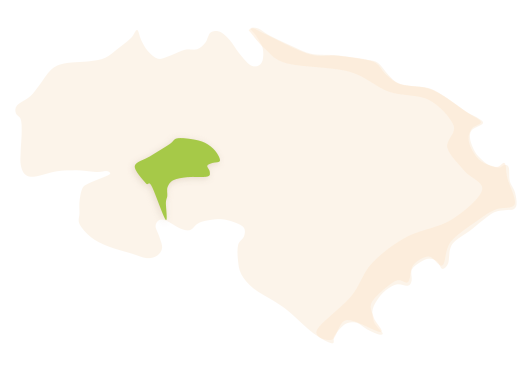La Vall de Laguar is located in a very mountainous area, in the interior of the region, on the upper course of the River Girona. It is one of the iconic four valleys called Les Valls de La Marina and is made up of three villages that form a single municipality: Campell or Poble de Baix, Fleix or Poble d'Enmig, and Benimaurell or Poble de Dalt. It is located at 437 metres above sea level, with a total area of 23 km² and a population of 843 inhabitants, known as Guarers and Guareres.
 La Vall de Laguar's municipal district. Surface area: 23 km². Population: 843 (INE data 2021).
La Vall de Laguar's municipal district. Surface area: 23 km². Population: 843 (INE data 2021).HISTORY
In this valley, the River Girona splits up the terrain and forms the ravine known as Barranc de L’Infern, affectionately called “the Cathedral of Hiking” (La Catedral del Senderisme). The municipality is submerged below this basin in the upper course and between the Penyó or Cavall Verd mountain range (800 metres) in the southern part and the mountain ranges known as Serra de Migdia and Serra d'Ebo (or Els Aspres) in the northern part. The hydrological wealth is evident in the numerous springs that flow all over the valley and by simply taking a look at the Isbert dam in the lower part.
The earliest signs of human settlement are Levantine-style, schematic and macro-schematic cave paintings found in rock shelters within the River Girona basin, dating from the Neolithic Era. But the current settlement was born during the Andalusian Muslim period and the toponym Laguar comes from Arabic, being an evolution of Al-Agwar which means “the caves”.
During the Andalusian period, there were four farmsteads that populated this valley: Benimaurell, Campell, Fleix and Isbert. These four farmsteads were defended and guarded by two fortifications: the castle of Atzavares (located in the lower part of the valley, opposite the current sanatorium of Fontilles) and by a watchtower in the upper part of the valley, known as La Casota.
One of the most bitter episodes of the modern era that affected the region and the entire Kingdom of Valencia had its climax in this valley: the rebellion of Laguar. With the publication of the Moorish expulsion decree signed by Felipe III on the 22nd of September 1609, some Moorish people from the interior valleys of this area rebelled and concentrated in La Vall de Laguar. Nearly 23,000 people arrived there from Ebo, Gallinera, Guadalest, Altea, and other places. They stood their ground and maintained the rebellion alive until the king's army cornered them on top of the Serra del Cavall Verd mountain range, where they endured eight days without water or food. Finally, they gave up and surrendered, and were thereafter taken to the port of Dénia and embarked towards exile in Orà.
After the expulsion, on the 14th of June 1611 a settlement charter was signed so that 31 resettlers born in Artà, 10 from Manacor, 7 from Llucmajor, 3 from Petra and so on (for a total of 69 islanders) could come and live in the valley. Proof of this fact are the surnames that are currently preserved by their descendants: Ballester, Moll, Mas, Mengual, etc.
The Fontilles sanatorium is noteworthy: originally for lepers, it is now a centre for the elderly. Laguar is a place with a manifest agricultural tradition that today continues to be recalled thanks to numerous dry-land fields that can be seen, with their olive trees, almond trees and, above all, cherry trees. These last fruit trees mentioned are the most famous ones and the inhabitants of La Vall de Laguar have a special affection for the cherries that grow there.
FESTIVITIES
- The festivities of El Campell are celebrated on the 25th, 26th and 27th of July.
- Fleix celebrates its patronal festivities on the first weekend of Easter and, on the 17th of May, the festivities of Saint Pasqual are held there.
- The festivities of Benimaurell are celebrated on the 22nd, 23rd and 24th of August.
- The pilgrimage to the Hermitage of Saint Josep (Romeria de l’Ermita de Sant Josep) is celebrated on the 19th of March.
GASTRONOMY
- Cold meats (black sausage, red and white sausage and sobrassada, a type of sausage typical from the Balearic Islands which is red and spicy).
Flatbreads, called “coques”. - “Arròs caldós amb fesols i penca”: soupy rice with kidney beans and cardoon stalks, which are called “pencas”.
- “Ronyoses”, a sweet made with almonds and sugar.